Game controller design is a fine art. An art that has, for the most part, been perfected over the last five decades.
In the old days, our palms seized up after using the Atari 2600 joystick for more than thirty minutes at a time. And “Nintendo Thumb,” a pain one could get in their thumbs if they played too much NES, was a strong reality for many (including my grandma, who as I’ve mentioned before, played lots of NES games back in the day).
Or how about the Xbox Duke controller, beef tanks that also doubled as anchors for the U.S. Navy? Likewise, the Wii-mote, which helped senior citizens the world over play hours of virtual bowling, but wasn’t made with traditional gaming experiences in mind.
Today, Sony’s Dual Sense controller, Nintendo’s Switch Pro Controller, and Microsoft’s Wireless Controller are all among the best ever created. Their smooth contours nestle snugly in the hands while still allowing you a rich, firm grip, ensuring your gaming sessions can last as long as you want them to.
To obtain near-perfection, however, controllers have undergone many disturbing permutations over the years. The following three examples are an unsettling mix of novelty, official first-party, and one that was wisely redesigned before release.
Steel yourself for…
THE WEIRDEST GAME CONTROLLERS OF ALL TIME!

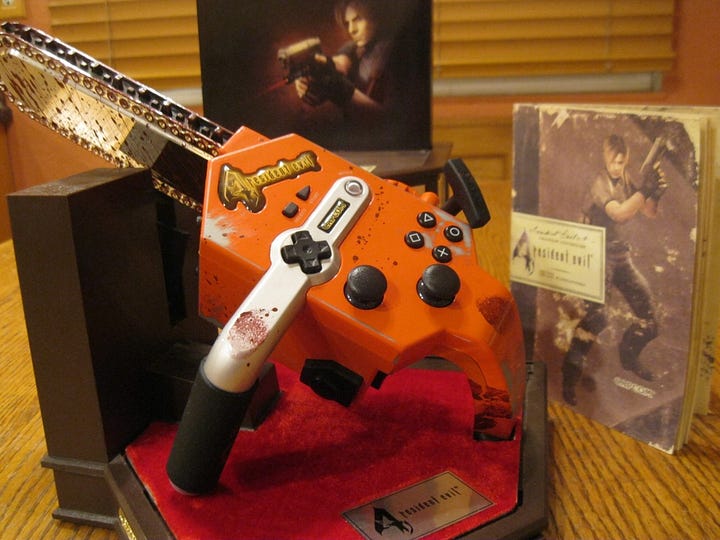
RESIDENT EVIL 4 CHAINSAW CONTROLLER – PLAYSTATION 2 AND GAMECUBE
There’s debate about whether the Resident Evil 4 Chainsaw Controller was ever intended to be used as a controller; either for RE4 itself or for any other game. The overwhelming consensus online from those who have wielded it say that the controller is a perfect showpiece, but doesn’t function very well.
Makes sense to me. The shape of a chainsaw doesn’t lend itself to comfortable controls. Let’s juxtapose a regular GameCube and PS2 controller with these shreddy bad boys.


Notice how the plastic handles on the GameCube/PS2 controllers extend downwards parallel to one another? This is so both hands can keep a firm grasp on the controller without either hand being positioned at an awkward angle.
Now consider the GameCube chainsaw controller.
The black handle juts out from beneath the first analog controller, as it should. But the yellow handle where your right hand goes is on the right side, perpendicular to the black handle. Obviously, this yellow handle placing makes the controller resemble a chainsaw more than if it had been placed parallel to the black handle. But trying to control the second analog via the yellow handle, along with all the buttons, including the shoulder buttons, looks like an uncomfortable chore. A solid way to damage your right wrist with extended use.
The PS2 chainsaw controller has an orange color, a fake steel chrome handle that looks far superior to the GameCube’s black plastic handle, and a ripcord that you pull to start the game. According to Console Variations, each controller is hand painted as well, which is insane. Nice touches, but the main problem remains: the handles run perpendicular to each other, not parallel. No matter how much you may want to play Resident Evil 4 with a fake plastic chainsaw, it’s just not worth the discomfort and frustration.
From a visual perspective, both controllers get the job done. Each very much looks like a disgusting chainsaw that has ripped through untold amounts of zombies. As a collectible intended to sit on your shelf next to other gaming oddities, they’re a success. As controllers you’d hope to use while blasting through miles of undead, they’re utter failures.
THE ATARI JAGUAR CONTROLLER
In 1993, controllers were still experiments, you never knew what you were going to get. For every successful advancement of the craft, like the SNES controller and Genesis 6-button pad, there were crimes against humanity like the CD-i’s remote control dealie and the Jaguar’s immense weapon of mass destruction.
Number pads were common on console controllers of the 80s, consoles like Atari 5200 and the Intellivision. I suppose the thought process was that people used the phone and TV remotes all the time, so why not have a number pad that looks like those much-used devices for your game controller. Beep boop beep, that’s how the old games are played.
The NES controller, with its economical D-pad, ‘Start’ and ‘Select,’ and two face buttons, destroyed that number pad nonsense for a brighter tomorrow. All controllers that followed in its wake added extra buttons for more complex games, sure, but the modern game controller’s basic framework was laid in 1985.
Atari, stuck in their glory days, drunk on their own musty vintage wine, gave their new “64-bit” system a controller with a number pad anyway. Supposedly, the pad is useful in racing games, shoot-em-ups, and first-person-shooters like Doom. Change the perspective in your racecar or spaceship by pressing 3, rotate through your weapon arsenal in Doom (don’t forget the chainsaw is set to 5). Maybe if you get stuck in Cannon Fodder, you can phone-a-friend for a little help. The only insight said friend can’t give, though, is why Atari thought the number pad needed to be included at all.
As for the rest of the controller? Serviceable, but uninspired. By this time – late 1993 – both the Genesis and SNES controllers had between four and six face buttons, in addition to two shoulder buttons. The Jaguar only has three face buttons and relies on the awkwardly placed number pad for additional functions. The D-pad is very wide and sunken into the controller. I’m sure the top half of the controller worked fine for most games, but when two-thirds of the controller’s real estate is taken up by a mostly worthless number pad, a redesign is in order.
All in all, the Jaguar controller is clunky, ugly, and needlessly oppressive. Not the controller of the future. In fact, the future is rightly and truly disgusted.
THE PLAYSTATION 3 BOOMERANG CONTROLLER
By the time of the PlayStation 3’s unveiling in E3 2005, Sony could no wrong. The PS1 and 2 were immediate successes and pushed the gaming industry forward with mature, revelatory titles; all while Nintendo sat around and made a bunch of party games for kids with the N64 and GameCube (great party games, mind you, but party games nonetheless).
Sony was the new kid on the block with the PS1, but they quickly grew into the Big Boss, incapable of making a mistake. Their decision to add DVD capability – a brand new video software that would soon dominate the industry – to the PS2 was a stroke of genius; I hope whichever Sony executive thought of that is now retired on several mattresses full of money.
At E3 2005, millions marveled at the bulky silver PlayStation 3. What mystical wonders lay inside? What new peaks of excellence would this console bestow on the Sony faithful? What the hell is that funky boomerang doing next to Sony’s shiny new digs?
As anyone who’s played a PS3 can tell you, this boomerang controller never made it to store shelves. According to a 2008 IGN article by Chris Roper, “Patrick Seybold, director of corporate communications and social media at Sony Computer Entertainment America, gave [IGN] an explanation for the change: ‘The original PlayStation 3 controller that was unveiled at E3 2005 was a design mock up that we wanted to get ready for the product's first unveiling. It was obviously met with a very vocal reaction, some in favor of and some not in favor of the design. After E3, while we were going through a variety of focus group tests across the globe, it was clear that the consumers and PlayStation fans wanted to experience their PlayStation 3 games with the familiarity and award winning feel of the Dual Shock design, and we made that change.’”
Such a shame. I want a world where Sony doubled down on their hubris and said, “Screw it, our system costs $600, it comes with a boomerang, and no good launch games, and you’re gonna buy it cause we’re Sony!” Cue lots of wicked laughter and lighting of many cigars.
This sucker would not have been fun to control. The D-pad and face buttons are fine, but the analog sticks are awkwardly located if you don’t have large hands. The shoulder buttons are a gamble, they could be alright, but they also look like they might be hard to reach. All told, a logistically cumbersome controller that would have been revised early on in the PlayStation 3’s lifespan, had it released.
For Sony to even consider this controller design as a possibility for their third console, is still incredible. Kudos to them for also showcasing the prototype at one of the world’s largest gaming expos with zero shame. The world will never know the joy of hurling an official Sony controller out the window in a fit of gaming rage, only to have it circle back around and hit you in the face, but we came close, friends. We came close.
*images courtesy of Reddit, Wikipedia
Plenty of weird controllers have been released over the last few decades. What are some of your favorites?


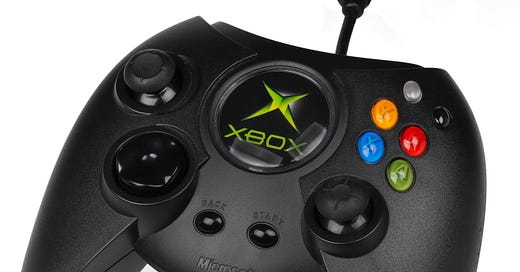




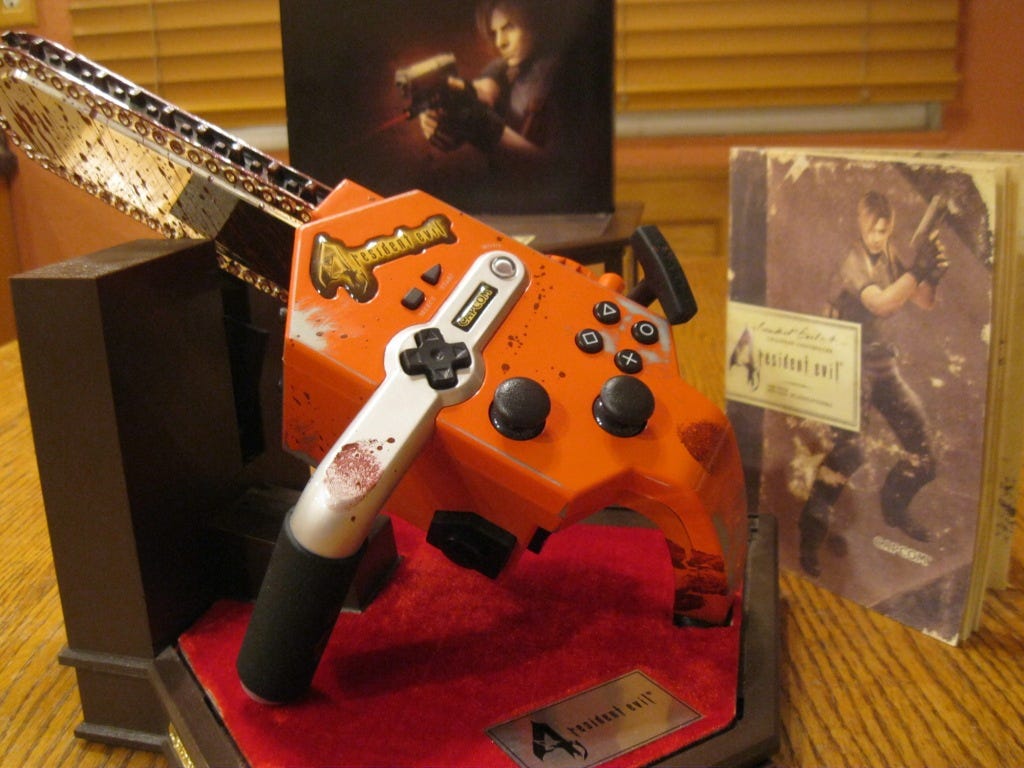
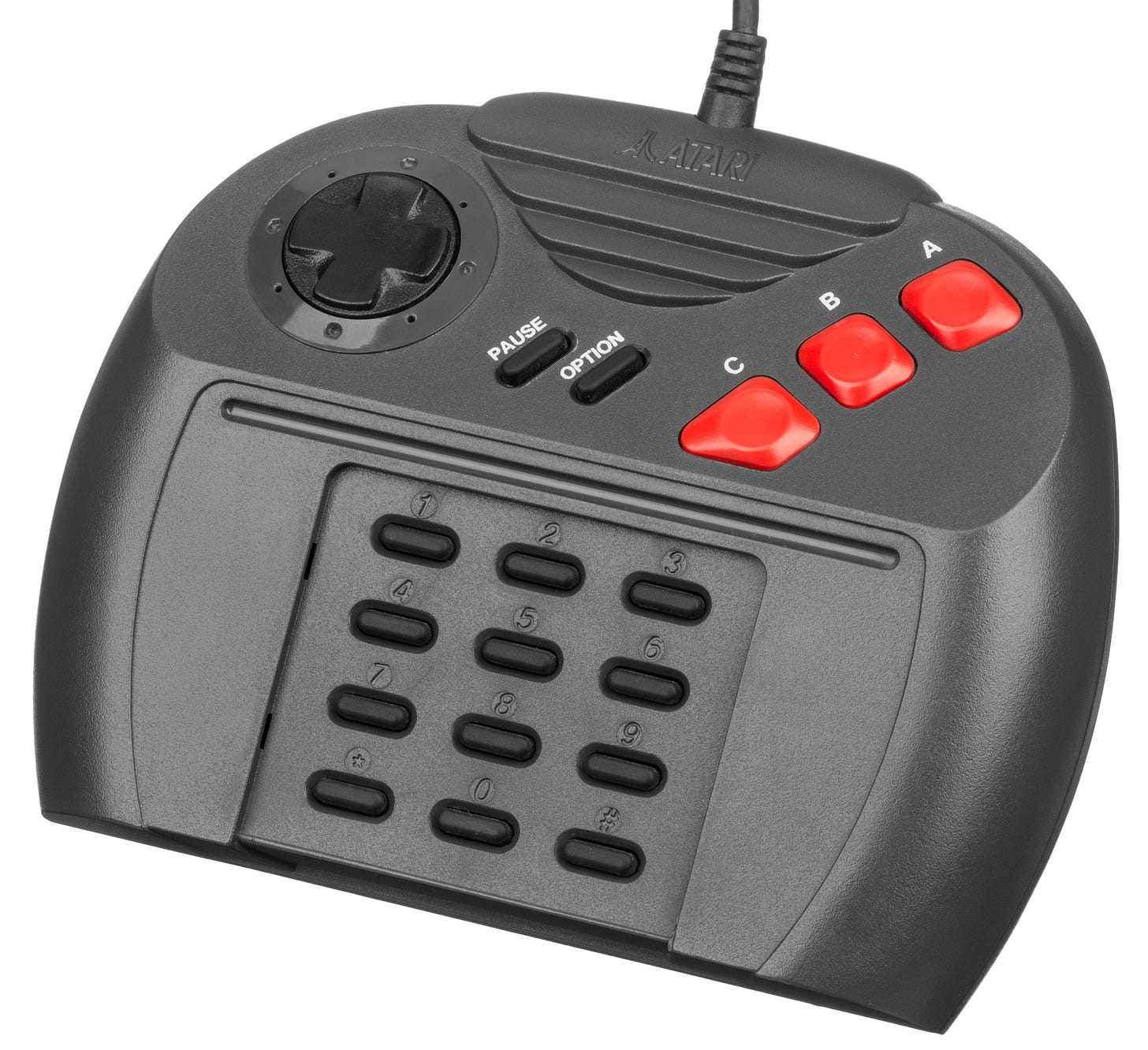
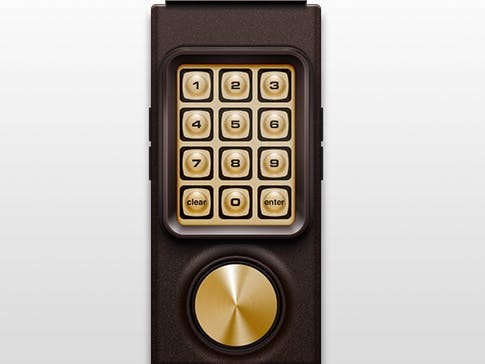
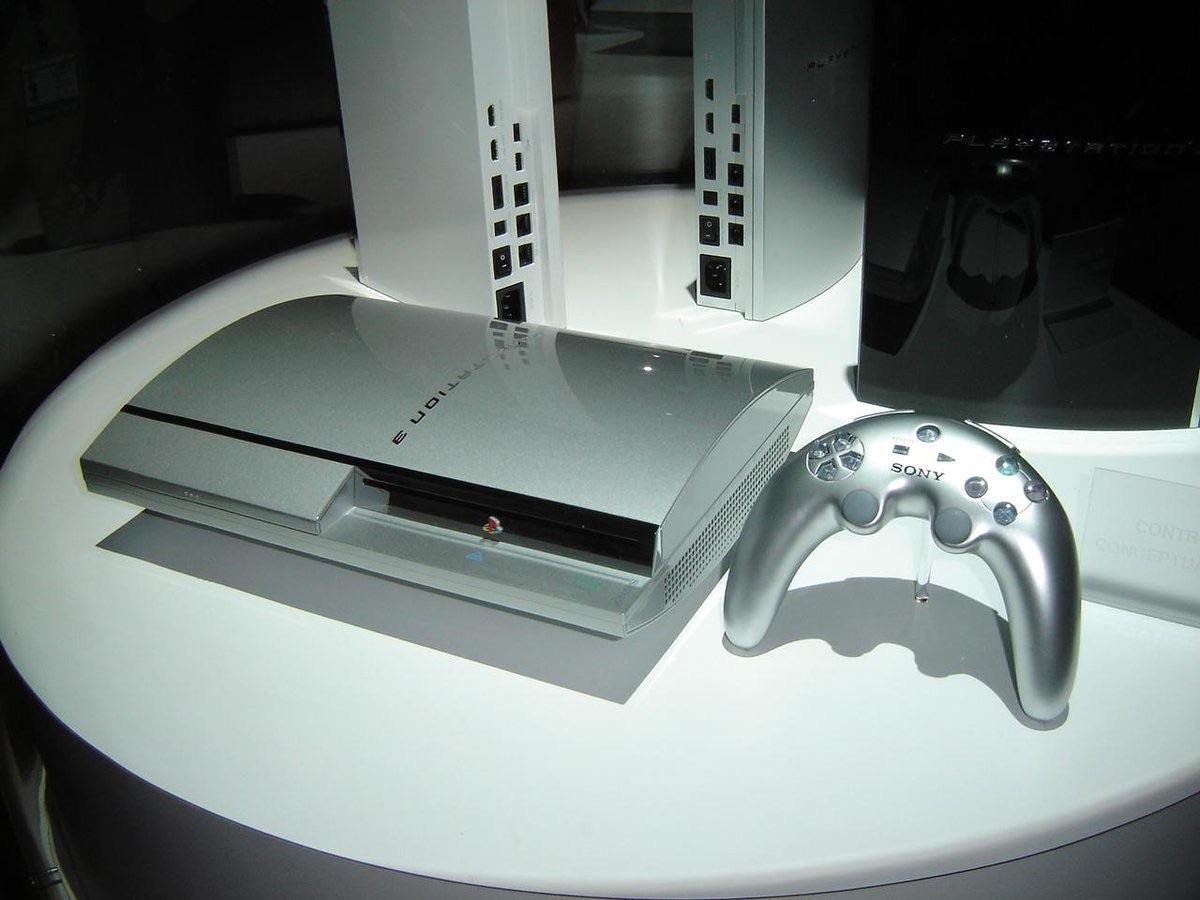
This was such a fun read, but also painful to imagine needing to hold on to them to play games.
I DO wish that there were some size options though...I have child-sized hands and some of the modern controllers are too big for me.
I hope they'll start innovating on this formula though -- I heard rumours that Sony was going to include heart rate and sweat production sensors on their PS5 controllers, but I don't think that ever came to fruition.
I just googled it (having never seen one in real life, for all the obvious reasons), and the Jaguar pad, for all its faults, had molded grips on the back. Was it the first controller to do this? If so, we should give it is due. It was the Wii U gamepad of its day—comfortable grips on the back and a big, useless thing in the middle.